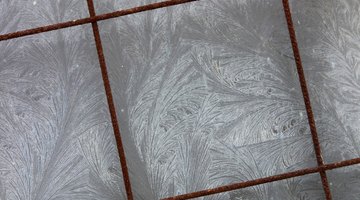Can I Install Tile on Concrete That Has Been Sealed?
Don't let the effort and time put into tiling a floor go to waste. The wrong subfloor under the tiles will prevent the tiles from properly adhering. Instead of tripping over the loose tiles, check your floor before laying the tiles. Concrete, though tough and durable, might require additional treatment before laying the tile, especially if a sealer was used on the concrete.

Sealed Concrete
A sealer is applied to concrete to smooth the surface and prevent it from absorbing stains. This surface prevents tile adhesive from sticking properly, and it must be removed. Another option requires you to lay a second layer of flooring such as cement backerboard or plywood on top of the concrete for better adhesion of the tile glue or thinset.
Checking for Sealer
There is a way to determine whether your concrete floor had a sealer or curing agent applied to it. Pour a small amount of water on the floor. Because sealers prevent the concrete from absorbing liquids, the water will bead on the surface of the concrete. If you determine that a sealer exists, you must remove or cover the sealer for tile to adhere to the concrete.
Removing Sealer
Sealers prevent the tile adhesive from getting into the crevices of the concrete to create a tight bond between the tile and concrete. Removing the sealer lets the tile mastic or thinset stick better. You need to rent, borrow or buy a sand blaster to get rid of the concrete sealer. This method requires you to fully understand how to operate the machine to avoid damaging the concrete floor under the sealer. If you are unsure of how to use a sand blaster, hire a professional.
Tile Adhesive Options
The tile adhesive you should use on top of your concrete floor after removing the sealer depends on how rough the surface is and where you are laying the tile. For surfaces you sanded smooth, opt for a dry-set mortar or organic adhesive. If the concrete remains rough after getting rid of the sealer, select an epoxy or Portland cement mortar. For damp areas, such as bathrooms or kitchens, use epoxy or Portland cement mortar. Dry-set mortar and adhesives are best for dry areas, such as hallways or bedrooms.
References
- Ortho's Home Improvement Encyclopedia Problem Solving A to Z; Charles G. Wing
- 2005 National Repair & Remodeling Estimator; Albert S. Paxton, et al.
- The Essential Guide to Decorating; Vinny Lee
- Ultimate Guide to Ceramic & Stone Tile: Select, Install, Maintain; Creative Homeowner
Photo Credits
- Hemera Technologies/AbleStock.com/Getty Images
- Hemera Technologies/AbleStock.com/Getty Images
More Articles



